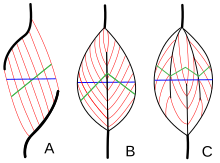Feathering
As Fiederung a design principle is called a skeletal muscle , the force (lifting) and the reduction in assets (lift) affects a muscle. In feathered muscles, the muscle fibers do not run parallel to their attachment tendons , but rather start at an angle to it. According to this criterion, muscles can be classified into the following groups:
- Simply feathered muscles ( Musculus unipennatus )
- Bi- pinnate muscles ( Musculus bipennatus )
- Multi-pinnate muscles ( Musculus multipennatus )
In a bi-pinnate muscle, a tendon splits into a fork shape. In multi-feathered muscles, branches of the two tendons radiate into the muscle belly, so that the muscle is sinewy. Such muscles are poor quality cuts of meat because they are very tough.
Lift capacity and lift height
The lifting force of a muscle depends on the cross section of all muscle fibers at right angles to their fiber direction ( physiological cross section ). In a non-feathered (parallel-fiber) muscle, this cross-section is the same as that through the entire muscle ( anatomical cross-section ) and the muscle power is transferred to the tendon without loss.
The lifting height depends on the length of the muscle fibers, which in turn depends on the number of contraction units ( sarcomeres ). A sarcomere can be up to 3.5 µm long at maximum pre-stretching and shorten to 1.5 µm in length during muscle contraction . This maximum shortening of around 60% does not occur in reality, however; under physiological conditions the sarcomere length with optimal pre-stretching is around 2–2.2 µm, which results in a shortening of around 30%.
Feathering angles
With the same muscle thickness, the feathering allows a larger number of muscle fibers to attach to the tendon, so the physiological cross-section is larger than the anatomical. The pennation (Pennationswinkel) affects both lifting height and lifting capacity.
The force (F S ) of a muscle (F M ) transmitted to the tendon decreases with increasing feathering angle (α) according to the formula:
F S = F M • cos α.
With a feathering angle of 60 °, only half the muscle force is transferred to the direction in which the tendon pulls. Due to the higher number of muscle fibers attached, however, the lifting force of a feathered muscle is greater.
The lift height (H) increases in feathered muscles in principle. In the case of fibers of the same length, it is not only determined by the shortening fraction, but also by the changing angle of feathering:
H = l 1 • cos α 1 - l 2 • cos α 2 ,
where l 1 and α 1 fiber length and attachment angle in front, l 2 and α are 2 after the contraction.
literature
- Franz-Viktor Salomon: muscle tissue. In: Anatomy for veterinary medicine. Enke, Stuttgart 2004, ISBN 3-8304-1007-7 , pp. 147-234.
